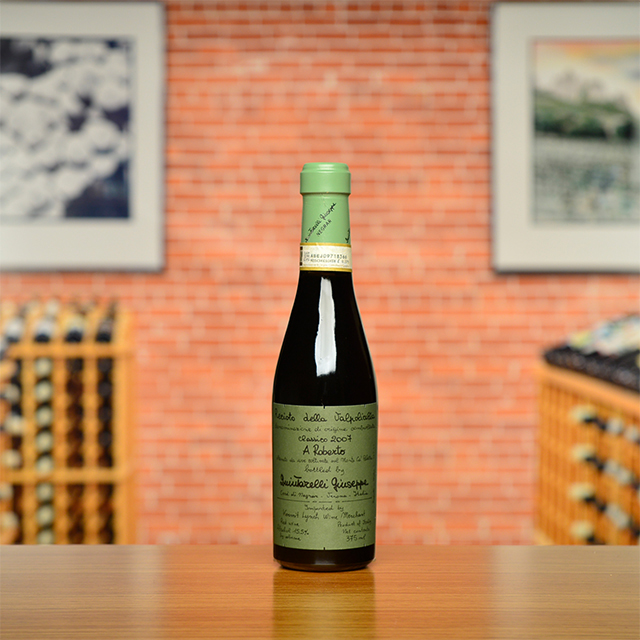Notify me
Prosecco Superiore Brut Magnum
Sommariva
Cinzia Sommariva’s Prosecco, hailing from the heart of the Prosecco zone near the town of Conegliano, is an obvious choice when looking for a wine for a celebration, or simply to enliven the senses. And while Prosecco maybe be very easy to drink, by no means is it easy to make. Cinzia and her parents farm thirty-five hectares of Glera, the Prosecco grape, in these gentle hills that lead into the towering Dolomites to the north. At Sommariva, the objective is quality, even if it means putting in extra effort, such as working sustainably in the vineyards and choosing to harvest by hand. While there is no doubt that Cinzia’s wine tastes great as an aperitivo or with a light antipasto, try drinking it over the course of an entire meal—like a true veneziano—to experience its remarkable versatility!
—Anthony Lynch
| Wine Type: | sparkling |
| Vintage: | NV |
| Bottle Size: | 1.5L |
| Blend: | Glera |
| Appellation: | Prosecco di Conegliano-Valdobbiadene Superiore |
| Country: | Italy |
| Region: | Veneto |
| Producer: | Sommariva |
| Winemaker: | Caterino & Cinzia Sommariva |
| Vineyard: | Up to 25 years, 35 ha |
| Soil: | Mineral-rich and Rocky Clay |
| Farming: | Sustainable |
| Alcohol: | 11.5% |
More from this Producer or Region

2020 Veneto Garganega “Sera”
Italy | Veneto
Four months of skin contact leaves this Garganega from Vignato Davide bursting with fragrant clementine and almond blossoms, while volcanic soil imparts lingering salinity.

2007 Recioto della Valpolicella Classico HALF BOTTLE
Italy | Veneto

2016 Alzero Cabernet
Italy | Veneto
Fresh and vibrant, bursting with every imaginable fruit, ripe off the tree.

Rosato Spumante Brut “Il Rosa”
Italy | Veneto
A spritzy rosato with scents of frutti di bosco and wildflowers.

2015 Recioto della Valpolicella Classico HALF BOTTLE
Italy | Veneto
This is the true alchemy of Quintarelli, a wine that has everything: fruit, length on the palate, and beguiling, layered aromatics.

Prosecco Superiore Brut
Italy | Veneto
With its light and elegant notes of citrus and orchard fruit, this is one of the stand-out, exquisitely crafted wines of this region.

Prosecco Superiore Brut Magnum
Italy | Veneto
Sommariva’s Prosecco is an obvious choice when looking for a wine for a celebration, or simply to enliven the senses.

2022 Veneto Frizzante “Primo Incontro”
Italy | Veneto
This is unadulterated, bone-dry, incredibly stimulating, low-alcohol Garganega frizzante from the unheralded volcanic hills of Gambellara.

Vino Spumante “Cuvée dei Vignato”
Italy | Veneto
Durella with a splash of Chardonnay—rich texture, laser-sharp acidity, and bone-dry finish.

Rosato Spumante Brut
Italy | Veneto
A spritzy rosato with scents of frutti di bosco and wildflowers.
About The Producer
Sommariva
About The Region
Veneto

Italy’s most prolific wine region by volume, the Veneto is the source of some of the country’s most notorious plonk: you’ll find oceans of insipid Pinot Grigo, thin Bardolino, and, of course, the ubiquitous Prosecco. And yet, the Veneto produces the highest proportion of DOC wine of any Italian region: home to prestigious appellations like Valpolicella, Amarone, and Soave, it is capable of excelling in all three colors, with equally great potential in the bubbly and dessert departments.
With almost 200,000 acres planted, the Veneto has a wealth of terroirs split between the Po Valley and the foothills of the Alps. While the rich soils of the flatlands are conducive to mechanization, high yields, and mass production of bulk wine, the areas to the north offer a fresher climate and a diversity of poor soil types, ideal for food-friendly wines that show a sense of place. Whether it’s a charming Prosecco Superiore from the Glera grape, a stony Soave or Gambellara from Garganega, or a Corvina-based red in any style, the Veneto’s indigenous grape varieties show real character when worked via traditional production methods.
Since his first visit in 1979, Kermit has regularly returned to the Veneto to enjoy its richness of fine wines and local cuisine. Our collaboration with Corte Gardoni, our longest-running Italian import, is a testament to this. The proximity of beautiful cities like Verona and Venice, with their deep culinary heritage, certainly doesn’t hurt, either.
More from Veneto or Italy
2015 Recioto della Valpolicella Classico HALF BOTTLE
Giuseppe Quintarelli Italy | Veneto
Rosato Spumante Brut
Sommariva Italy | Veneto
2015 Recioto della Valpolicella Classico
Giuseppe Quintarelli Italy | Veneto
2022 Veneto Frizzante “Primo Incontro”
Davide Vignato Italy | Veneto
Rosato Spumante Brut “Il Rosa”
Sommariva Italy | Veneto
2023 Prosecco Treviso Sui Lieviti
Gregoletto Italy | Veneto
2016 Alzero Cabernet
Giuseppe Quintarelli Italy | Veneto
2020 Veneto Garganega “Sera”
Vignato Davide Italy | Veneto
2007 Recioto della Valpolicella Classico HALF BOTTLE
Giuseppe Quintarelli Italy | Veneto
Vino Spumante “Cuvée dei Vignato”
Davide Vignato Italy | Veneto
Prosecco Superiore Brut
Sommariva Italy | Veneto
Prosecco Superiore Brut Magnum
Sommariva Italy | Veneto
2015 Recioto della Valpolicella Classico HALF BOTTLE
Giuseppe Quintarelli Italy | Veneto
Rosato Spumante Brut
Sommariva Italy | Veneto
2015 Recioto della Valpolicella Classico
Giuseppe Quintarelli Italy | Veneto
2022 Veneto Frizzante “Primo Incontro”
Davide Vignato Italy | Veneto
Rosato Spumante Brut “Il Rosa”
Sommariva Italy | Veneto
2023 Prosecco Treviso Sui Lieviti
Gregoletto Italy | Veneto
2016 Alzero Cabernet
Giuseppe Quintarelli Italy | Veneto
2020 Veneto Garganega “Sera”
Vignato Davide Italy | Veneto
2007 Recioto della Valpolicella Classico HALF BOTTLE
Giuseppe Quintarelli Italy | Veneto
Vino Spumante “Cuvée dei Vignato”
Davide Vignato Italy | Veneto
Prosecco Superiore Brut
Sommariva Italy | Veneto
Prosecco Superiore Brut Magnum
Sommariva Italy | Veneto
Kermit once said...

Kermit once said...
You don’t have to be rich to cellar a great wine.
















